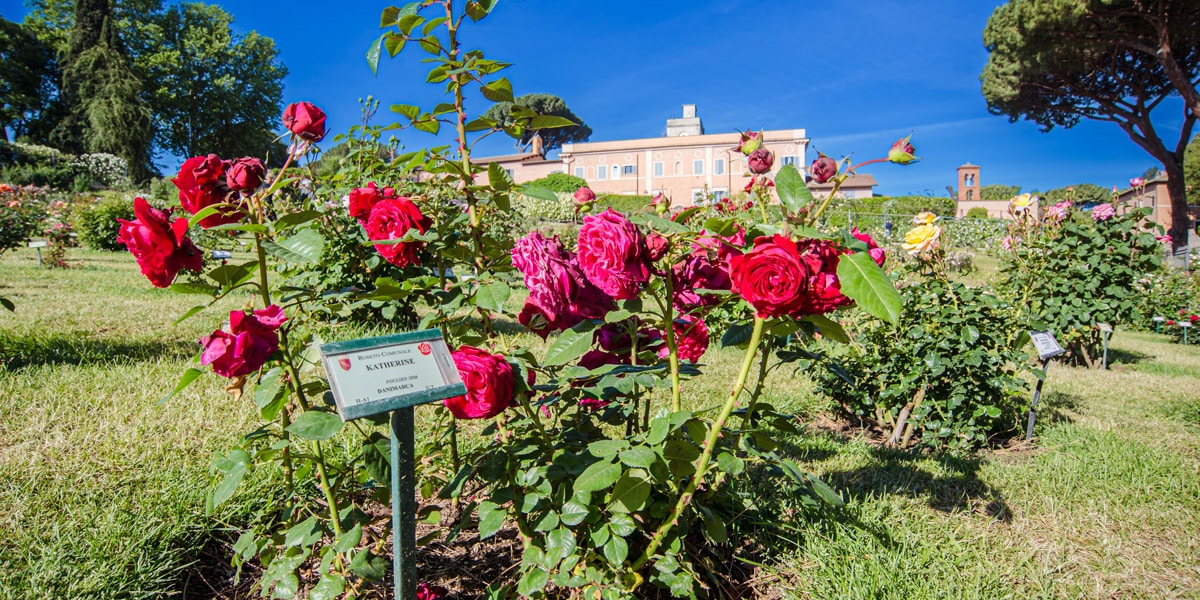

24841 views
Written by: Artur Jakucewicz

| Tip | The peak bloom is mid-May to early June. The garden is typically open from late April to mid-June, and sometimes for a shorter autumn bloom (October). Admission is free, but opening dates and hours may vary each year due to the weather. |
|---|---|
| Opening Hours |
Sunday:
-
Monday:
-
Tuesday:
-
Wednesday:
-
Thursday:
-
Friday:
-
Saturday:
-
|
| Address | Via di Valle Murcia, 6, Rome |
Rome’s Rose Garden (Roseto Comunale) on the Aventine Hill is one of the city’s most enchanting—and fleeting—attractions. Each spring, over 1,100 varieties of roses from around the world burst into colour, transforming this historic hillside into a fragrant sea of pinks, reds, yellows, and whites. With free entry and breathtaking views of the Palatine Hill and Circus Maximus, the Roseto Comunale is a must-visit for flower lovers and photographers alike.
The Roseto Comunale is open for only a few weeks each year—catch it in bloom for an unforgettable Roman experience.
Contents
ToggleRome’s Rose Garden was first created in 1931 on Colle Oppio, near the Colosseum, before moving to its current location on the Aventine Hill in 1950. The site itself is deeply historic—it was once Rome’s Jewish cemetery (1645–1934). In honour of this legacy, the garden’s paths are designed in the shape of a menorah.
The Roseto Comunale is also a living laboratory of botanical innovation. Almost all modern roses have been hybridised by breeders since the late 1800s, and today there are more than 40,000 recognised varieties worldwide. Rome’s Rose Garden alone showcases around 800 types (including Hybrid Teas, Floribundas, Shrubs, Ground Covers, Miniatures, and Climbers), representing a dazzling range of colours, forms, and fragrances.
Creating a new rose is a work of patience and expertise: breeders spend at least five years developing a single hybrid. Most of these experimental roses are discarded, and only 2–3% are considered truly interesting. Of the many crosses, just 10–15% will even produce seeds, and only a fraction of those will grow successfully. Among the huge number of modern roses, many are lookalikes, making it increasingly challenging to create a truly unique flower, especially with new qualities like disease resistance, hardiness, or the ability to rebloom.
The Roseto Comunale is much more than a scenic park; it’s a testament to human creativity, scientific rigour, and a love for beauty that spans generations.
The Rose Garden is one of my favourite places in Rome. I love to come here early in the morning, in the first hour right after opening. At this peaceful time, you can still see dew glistening on the rose petals, listen to the birdsong, and take in the magical views of Rome waking up beyond the blooms.
Below are my favourite details of the garden that I always advise visitors to pay special attention to. Each offers a unique perspective and a moment of wonder—don’t miss them during your walk!
As you step into the garden, make your way up the central steps to this stunning rose-framed archway.
In the second half of April, these blooms are at their most vibrant, welcoming you into the heart of a sea of color.
Look up, and you’ll see the majestic umbrella pine trees—a true symbol of Rome—rising elegantly behind the garden. Against this lush backdrop, the combination of ancient pines and a carpet of roses creates one of my absolute favorite views in the entire city. Take a moment here to soak in the morning light and capture a photo that blends floral beauty with the iconic Roman skyline.
Just beneath the rose-covered heart of the garden, you’ll find a charming little drinking fountain sculpted in the shape of a playful dolphin.
Look closely at the top and you’ll see the inscription “ACQVA MARCIA”—the name of one of Rome’s most famous ancient aqueducts, which has supplied pure water to the city since 144 BC.
This isn’t just a whimsical detail—it’s a nod to Rome’s history of remarkable engineering and its tradition of beautiful public fountains. If you’re curious, you can learn more about the Aqua Marcia aqueduct and others at the Park of the Aqueducts. Pause here to refresh yourself with cool water, and appreciate how even a simple fountain connects you to centuries of Roman life.
Once you reach the very top of the garden, turn right and stroll a short distance—you’ll discover inviting benches framed by enchanting tunnels of blooming roses.
This is one of my favorite places to take a break: sit beneath a canopy of petals, breathe in the fragrance, and simply enjoy the peaceful beauty of the Roseto Comunale. In the morning, you’ll often have this tranquil spot almost to yourself.
For added convenience, you’ll find a free public toilet nearby—an especially welcome amenity since there aren’t many bars or restaurants in the immediate area. It’s one more reason this corner of the garden is perfect for a longer, relaxed visit.
As you wander freely through the garden, take time to notice the little plates by each rose bush.
Every plate lists the rose’s name and the year—and often the country—when that variety was first bred. It’s a delightful detail that makes each plant feel unique and storied.
Turn your stroll into a game: search for a rose bred in the year you were born, or spot a variety with the same name as someone close to you. These discoveries add a playful, personal touch to your visit, and you’ll find yourself drawn into the living history of the Roseto Comunale.
Whether you’re using a smartphone or a DSLR, let yourself experiment—every corner of the Roseto Comunale offers a new perspective and a touch of magic.
Author: Artur Jakucewicz
This website uses cookies. For more info read the cookies policy
Rome.us © 2025. Created with love by Roman experts and guides.